Feature
NASA’s Universe of Learning
Building an Informal Learning Network
Connected Science Learning January–March 2020 (Volume 2, Issue 1)
By Erika Wright, Timothy Rhue II, Mary Dussault, and Brandon Lawton
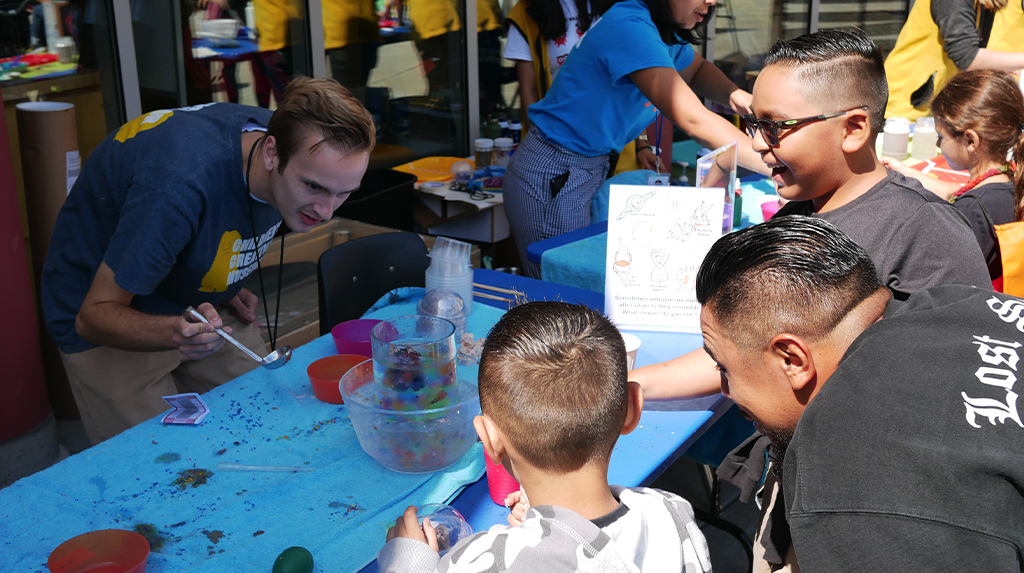
What happens when you ask scientists and educators from some of the nation’s top astrophysics research organizations to partner with informal learning institutions from across the country to create learning opportunities to engage local audiences in exploring the universe? You get out-of-this-world, innovative science learning experiences that showcase the strengths of collaborations across disciplinary boundaries!
NASA’s Universe of Learning (UoL) works to strengthen science learning and literacy for youth, families, and lifelong learners through its Informal Learning Network. NASA’s UoL is a unique partnership between the Space Telescope Science Institute (STScI), Caltech/IPAC, Jet Propulsion Laboratory, Exoplanet Exploration Program, Smithsonian Astrophysical Observatory (SAO), and Sonoma State University. These organizations hold a direct connection to the science and missions of NASA, being the homes of science operations and communications for NASA missions such as the Hubble Space Telescope, Spitzer Space Telescope, and Chandra X-ray Observatory, as well as the scientists and engineers who work on programs across the spectrum of NASA Astrophysics.
NASA’s UoL provides resources and experiences that enable learners to explore fundamental questions in science, experience how science is done, and discover the universe for themselves. Its goal is to create pathways for learners with varied needs and interests to engage with the content in a way that that motivates them to explore astronomy further. Working together, these science-rich institutions aim to connect learners with key astronomical concepts like the history and origins of the universe, the life and death of stars, other planets and solar systems, and more. Drawing on the Strands of Informal Science Learning framework (Bell et al. 2009), NASA’s UoL resources are designed to help learners of all ages develop their interest in astronomical phenomena, participate in scientific practices, and develop their STEM identities (NRC 2009).
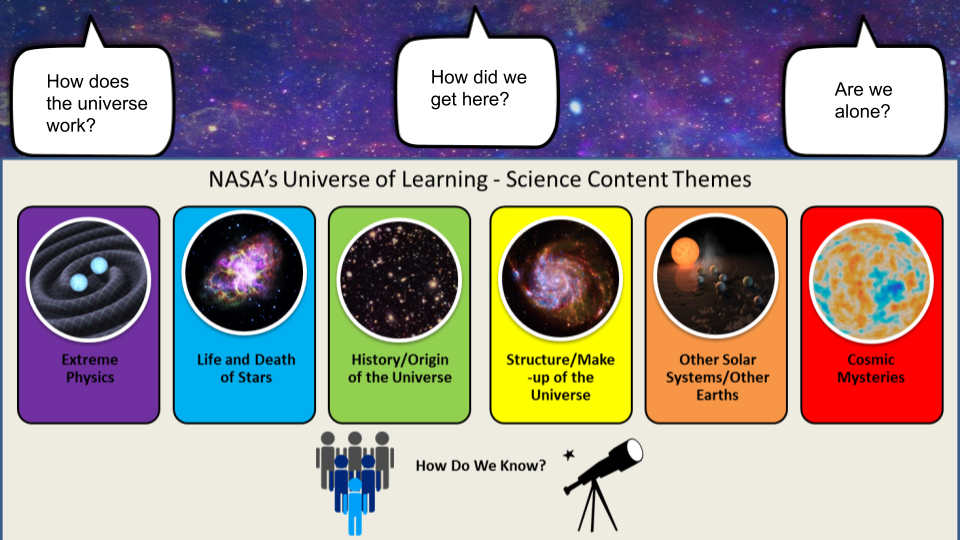
In a 2010 report on collaborations between informal science education organizations and schools, authors from the Center for the Advancement of Informal Science Education (CAISE) argue that informal settings and science-rich cultural organizations have assets that can support schools and communities in meeting the shared goals of making STEM learning more accessible and compelling to young people, particularly those from underrepresented groups. They call for more program experiments that can test models of these formal-informal collaborations in programs such as supplementary classroom experiences, teacher professional learning programs, and out-of-school-time student science learning communities (Bevan et al. 2010a). NASA’s UoL’s Informal Learning Network, led by STScI and SAO, aims to bring its innovative resources and scientific connections to the public through partnership with organizations that know their local learners and communities best. NASA’s UoL Informal Learning Network collaborates with the Association of Science and Technology Centers (ASTC) and Smithsonian Affiliations to engage their national networks of museums, science centers, and other informal learning institutions, most of which also have strong connections with their local school systems.
The collaboration between NASA’s UoL, ASTC, and Smithsonian Affiliations developed gradually over the past five years. SAO and Smithsonian Affiliations previously partnered to create Youth Capture the Colorful Cosmos, a program for middle school youth that was the inspiration for this project (Baum 2013; Baum 2015). SAO also has a strong relationship with ASTC, having built and distributed traveling astronomy exhibits through ASTC in the past. Likewise, prior collaborations and close relationships between partner institutions helped to initially form NASA’s UoL. Building on these relationships developed through past projects, NASA’s UoL was able to expand the collaborative community of informal learning sites working together to engage learners in NASA astrophysics.
The overall goal of NASA’s UoL Informal Learning Network is to support ASTC and Smithsonian Affiliation members in creating adaptable examples of astronomy-themed learning experiences that engage members of their local audience, particularly those that are underserved or underrepresented in the sciences. These experiences are to be documented and shared with a wider network of STEM learning stakeholders across the ecosystem of formal and informal environments. The collection of documented program examples is referred to as “NASA’s UoL program models.” As a result of this collaboration, a national web of informal learning institutions has designed and tested dozens of innovative STEM learning program models. These models combine the best assets of each partner, using NASA Astrophysics resources to make STEM learning more accessible and compelling.
Supporting partnerships through a Community of Practice
The primary mechanism of this partnership was to establish and nurture an ongoing community of practice, both online and face-to-face. Researchers have defined a community of practice as a group whose members share a passion for something they do and learn how to do it better as they interact regularly and share and produce communal resources (Wenger 2000; Wenger 2006). Different communities have different levels of participation, from core members who actively participate in conversations to peripheral participants who gain insight through observation (Lave and Wenger 1991). NASA’s UoL Community of Practice is for NASA-funded science educators and researchers and individuals from partnering organizations to learn how to use NASA’s UoL resources effectively for authentic astronomy-based learning experiences. Over the four years of the project to date, participation in the Community of Practice has included the following activities:
- A series of core introductory webinars hosted by NASA-funded educators and scientists
- Online collaboration spaces for asynchronous discussion and exploration of resources
- Development and implementation of astronomy-themed learning experiences
- Documentation and sharing of program models
- Participation in reflection and feedback sessions, as well as in evaluation
- Leadership activities by community members presenting at conferences and for a wider community of professional peers
To initiate the Community of Practice, NASA’s UoL Informal Learning Network team worked with ASTC and Smithsonian Affiliations to create and implement professional learning experiences through a series of seven hourlong webinars, hosted biweekly. The Informal Learning Network team addressed NASA’s three big astrophysics questions: “How does the universe work?” “How did we get here?” and “Are we alone?” Participants in the webinars were introduced to a new topic in astrophysics each week, such as searching for life in the universe or how looking out at the sky is looking back in time. Astronomy education professionals would provide background on the topic, and astronomers who are actively researching the universe shared some of their relevant work. The webinars also provided resources about the topic of the week and ways those resources had been used for learning in the past. For example, resources provided for the “Are we alone?” webinars included:
- interactive data visualizations such as Eyes on Exoplanets,
- activity plans such as Trappist Size and Scale,
- poster exhibits such as the Exoplanet Travel Bureau, and
- opportunities to participate in authentic science using robotic telescopes such as DIY Planet Search.
These webinars were the beginning of the larger Community of Practice. Online community spaces for ASTC members and Smithsonian Affiliation members, known as Smithsonian Affiliates, acted as a vehicle for following up on the webinars. The community space introduced participants to content areas and resources in a way that was scaffolded and approachable. Participants could continue discussions from the webinars, share ideas for programming, ask further questions of NASA’s UoL scientists, and report on the status of their programs. By building a support network, educators increased their capacity as learners. They had a place to ask questions and support others who have questions, share their experiences, and learn from the successes and challenges of others.
Throughout three rounds of professional development, the Informal Learning Network has engaged over 200 individuals from over 100 organizations in the Community of Practice. Forty-eight organizations with participating staff received modest stipends from NASA’s UoL program to kickstart the development of a variety of exhibits, events, and programs. All 48 went on to pilot astronomy-themed learning experiences with their audiences and document these as program models.
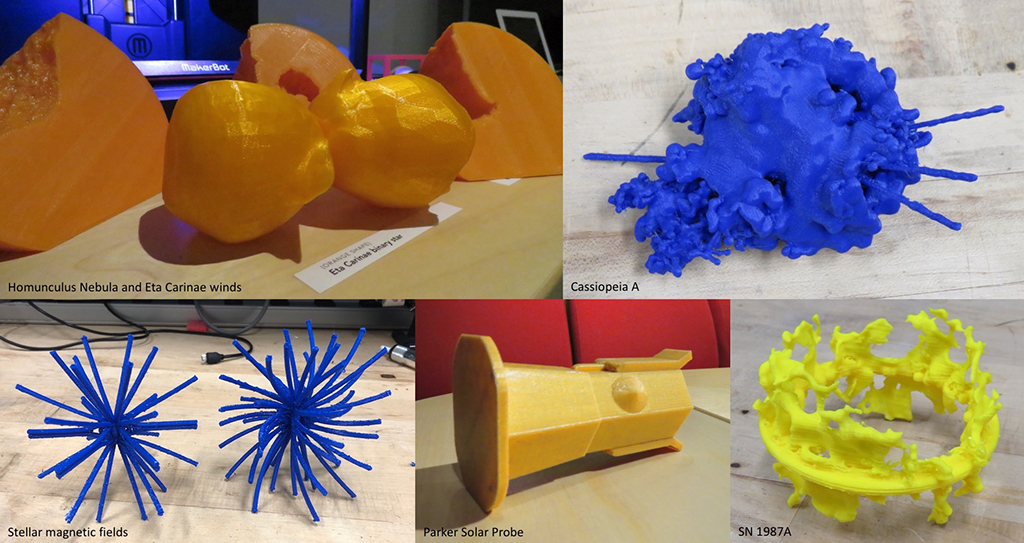
Partnership With ASTC and Smithsonian Affiliations
The partnership between NASA’s UoL, ASTC, and Smithsonian Affiliations was critical to creating a successful program. Each partner brought their unique knowledge and experiences to the table; having the right mix was essential.
ASTC and Smithsonian Affiliations guided the structure of the program to best meet the needs of their members. Both organizations contributed infrastructure support such as hosting the webinars, and managed logistics like the distribution of funds for their respective networks. NASA’s UoL developed much of the content, including the webinars and various astronomy resources that organizations have incorporated into their designs for learning experiences. Astronomers and astronomy educators from across the country connected with the program to share their expertise and discuss how to introduce it to novice science learners. The webinars were adjusted based on feedback from ASTC and Smithsonian Affiliations to better address the needs of museum professionals. For example, webinar facilitators realized that they needed to prioritize discussion of practical ways that the digital resources could be used in a museum environment over explanations of the background science. Further adjustments were made to make content accessible to those without any science education experience; as a result, the partnership was able to draw in sites such as libraries and art museums to participate.
Working together to build innovative program models
"This was a great webinar series with very useful information. The funding provided a lot of freedom in planning an event that fit our museum’s mission.”
—Cheyanne Suffka, Frontiers of Flight Museum
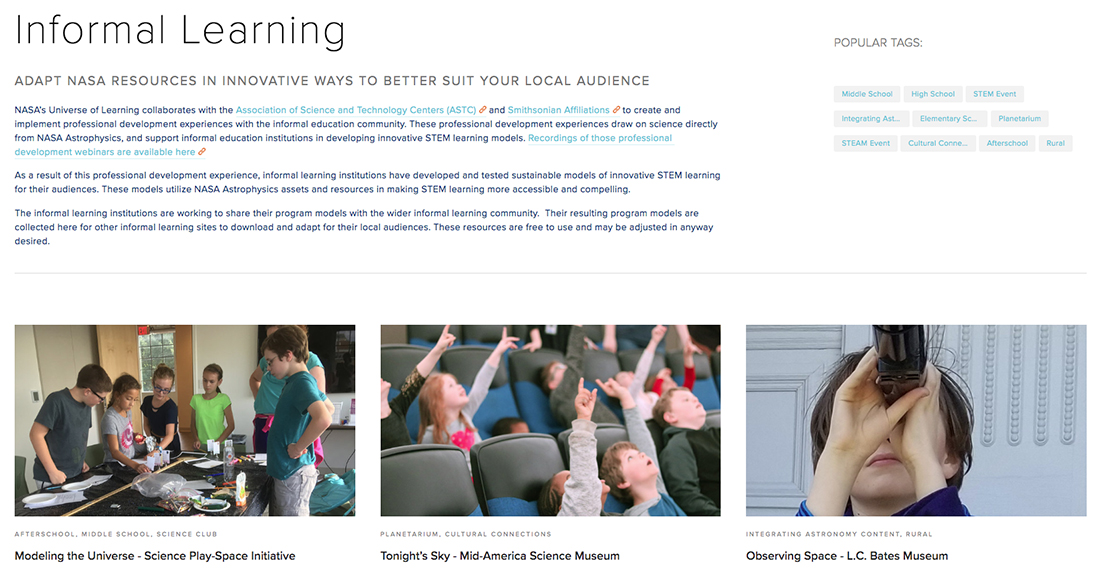
Once armed with new content and a collection of resources, the informal learning institutions took the lead in developing and documenting a total of 28 unique program models (with 20 more currently under development) that each have their own distinct connection to NASA astrophysics. Each institution had the freedom to design their learning experiences in a way that would best connect with their audiences while drawing upon their organizational strengths and knowledge. During the design and development phase, participants continued to collaborate with NASA’s UoL team, seeking feedback from subject matter experts and help finding resources to best support their vision for an engaging program. Many also took this opportunity to extend the network of collaboration by working with schools, libraries, and nonprofits local to their institution. The seed funding for implementation allowed them the freedom to reach out and initiate partnerships they had been eager to explore. In applying for seed funding, sites were strongly encouraged to describe specific ways that they would work with audiences from groups underrepresented in STEM to customize their program.
The specific programs, events, exhibits, and experiences that have been developed engage a spectrum of audiences, from toddlers to adults to educators, each with a different take on how to bring the mysteries of the universe to a public audience. These programs range from large public family days, to fifth day programming designed in collaboration with rural public school systems, to special sensory events for visitors who are neurodivergent. Reports from sites implementing programs indicated that these astronomy-themed learning experiences have reached over 100,000 people, and that reach is expected to extend as the programs are implemented again by the original partners and as new organizations adapt the documented program models for their own use in the future. The unique perspective and multidisciplinary approaches introduced by the partner informal learning institutions has created a suite of program models that NASA’s UoL could not have imagined without this partnership. While each informal institution initially collaborated with NASA’s UoL to develop its own programming, the Community of Practice is moving toward more cocreative activities, where participants share and borrow ideas from each other to improve and adapt their astronomy-themed experiences.
There is no one model of OST [out-of-school time] STEM. Most programs are designed to reflect local resources, needs, and communities, and therefore program goals, design, and outcomes vary widely. This diversity enriches the science learning landscape, providing multiple points of entry for many different learners.” (Bevan et al. 2010b)
Three examples of astronomy-themed learning experiences developed by participating organizations are provided below. Each example highlights collaborations between different stakeholders in the STEM learning ecosystem and takes important steps toward bridging the gap between formal and informal learning experiences. The documentation of these examples as program models can be found here on NASA’S UoL website.
Pensacola MESS Hall
The Pensacola MESS Hall (Math, Engineering, Science, and Stuff) found a new way to use existing programming: building a themed field trip for students in grades 5–7. The organization has experience tailoring their programs for rural students in Escambia and Santa Rosa Counties in Florida and Baldwin County in Alabama. Using their preexisting relationships with teachers in those counties, they were able to attract an audience for this new standards-aligned field trip that pulled material from NASA’s UoL, NISE Net, and the Solar System Ambassadors, among others.
The field trip “Mission: The Universe” starts off with an interactive show where students create a scale model of Earth, the Moon, and Mars—three celestial objects with which they are familiar. The incredible distance that they see is used to hint at what must be beyond our solar system. The students then visit eight different stations to learn about our universe, creating a scale model of a planetary system around another star, packing a space telescope, designing a mission patch, and more. The group reconvenes and reviews a few of the takeaways from the different stations before closing.
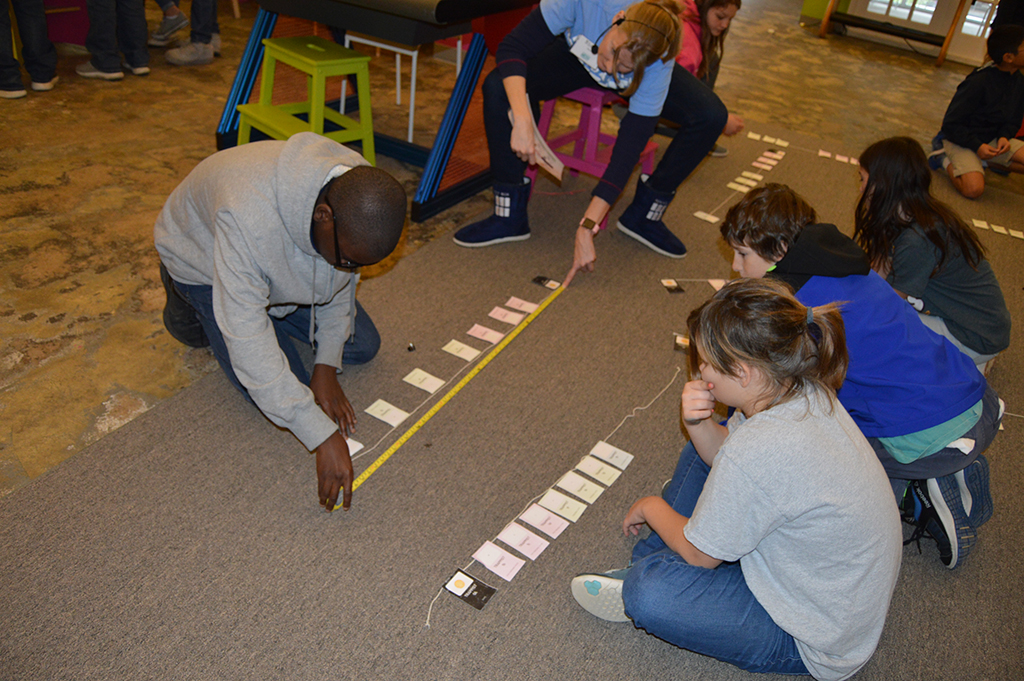
Pensacola MESS Hall was able to bring together resources from a number of different organizations, work with those organizations to tailor their resources to their program needs, and draw together an audience from the schools they work with regularly. Those resources are all available online and can be used by any organization in their current form, broken down into their component parts and used individually, or adapted in some other way as needed for another audience.
Children’s Creativity Museum
"The educators at CCM came away from this experience with a positive impact on their views of working with subject matter experts and using more space science content. Introducing more STEM content at the museum has been slowly gaining traction through projects like this one. Putting creativity at the core of these activities really helped educators feel more empowered to share this type of content with our visitors.”
—Darrell Porcello, Children’s Creativity Museum
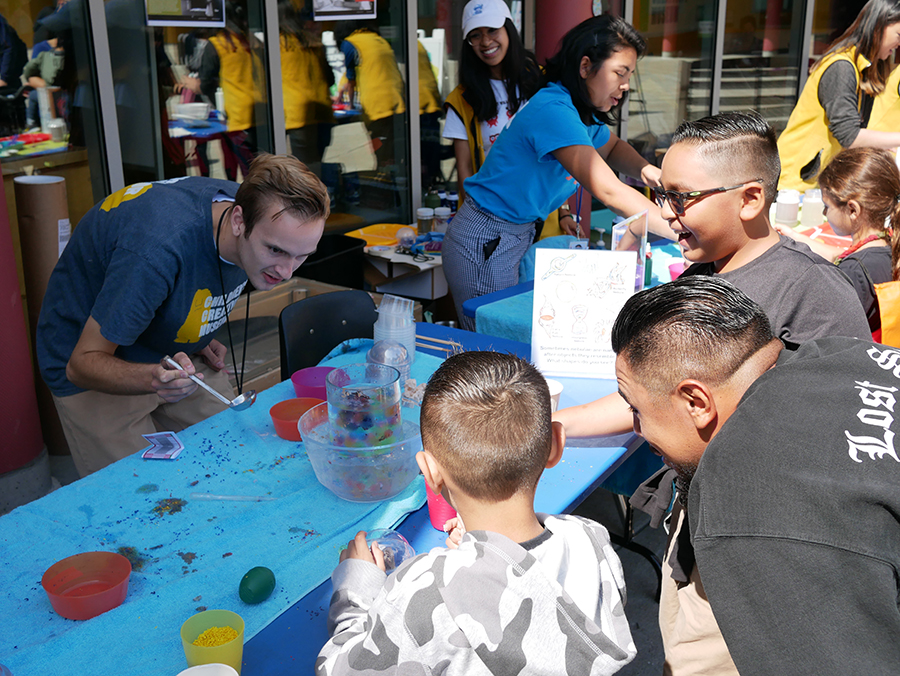
It is often considered a bridge too far to engage elementary students with astrophysics content. At the Children’s Creativity Museum in San Francisco, California, which specializes in working with early childhood learners, educators collaborated with NASA subject matter experts to create developmentally appropriate ways to engage a younger audience with ideas around the life and death of stars. Now that these resources exist, they can be shared during school field trips and with afterschool educators, or can even be used directly by classroom educators.
The Children’s Creativity Museum (CCM) created an experience called “Space Art Explorations.” This is a prototype STEAM festival specifically designed for children’s museums that features three hands-on activities: Nebulae Spin Art, Shaving Cream Nebula Prints, and Hot Wax Nebula Creations. These activities were designed for children as young as four years of age, with CCM bringing their unique strengths in making complex topics relevant to children from a variety of cultural backgrounds. In the activities, children use a variety of materials including paint, shaving cream, water, spoons, salad spinners, cheese graters, and wax to create their own unique art. In the process, the children learn about how planetary nebulas form in space by mimicking some of the physical processes of nebula formation. CCM created simple graphics and trained their staff to describe nebulas as “nature’s way of mixing things up.” For example, in the Hot Wax Nebula Creations activity, visitors add crayon shavings and glitter symbolizing elements and space debris into hot wax. The wax is then added to a spinning vortex of cold water filled with a variety of sensory toy orbs. The vortex and orbs mimic planets and stars and the natural spin inherent in systems creating a planetary nebula. Signage for these activities pulls pictures from Astropix, a UoL resource and archive of NASA images.
CCM worked closely with NASA’s UoL to develop programming that was not only pedagogically appropriate for their young visitors, but also scientifically accurate. Dr. Rudolfo Montez, an expert in planetary nebulas from the Chandra X-ray Center, helped CCM educators understand and identify the characteristics and features of nebulas to develop the activities. This collaboration drew on the strengths of both partners: NASA’s UoL typically focuses on creating astrophysics-themed products for preteen and older audiences, so CCM was able to bring in their expertise in early childhood education and creating developmentally appropriate activities. CCM had not worked with astrophysics content before, and the partnership helped bring a new, exciting field of content to their audience with built-in buy-in.
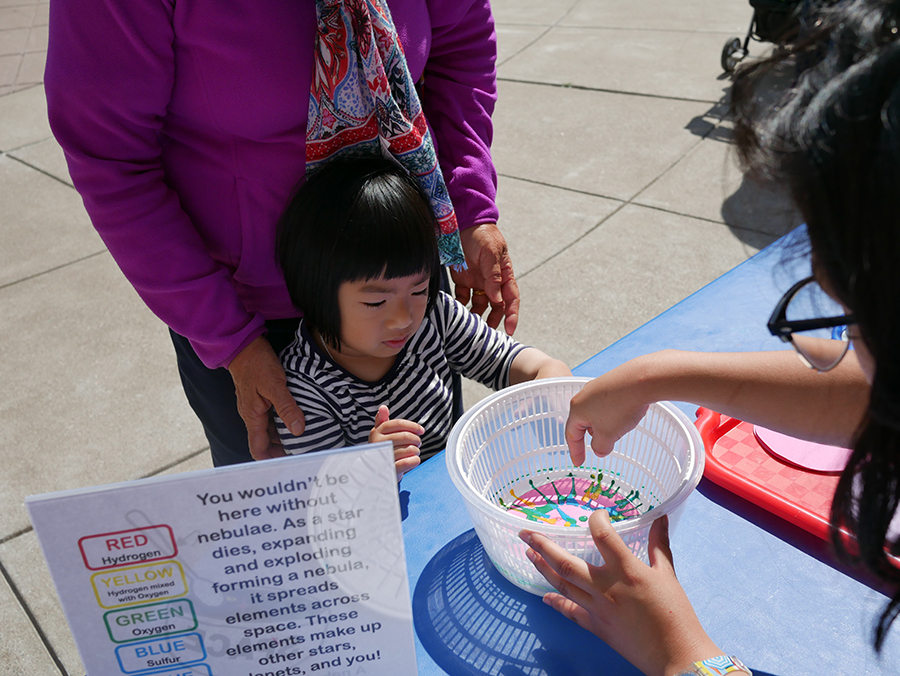
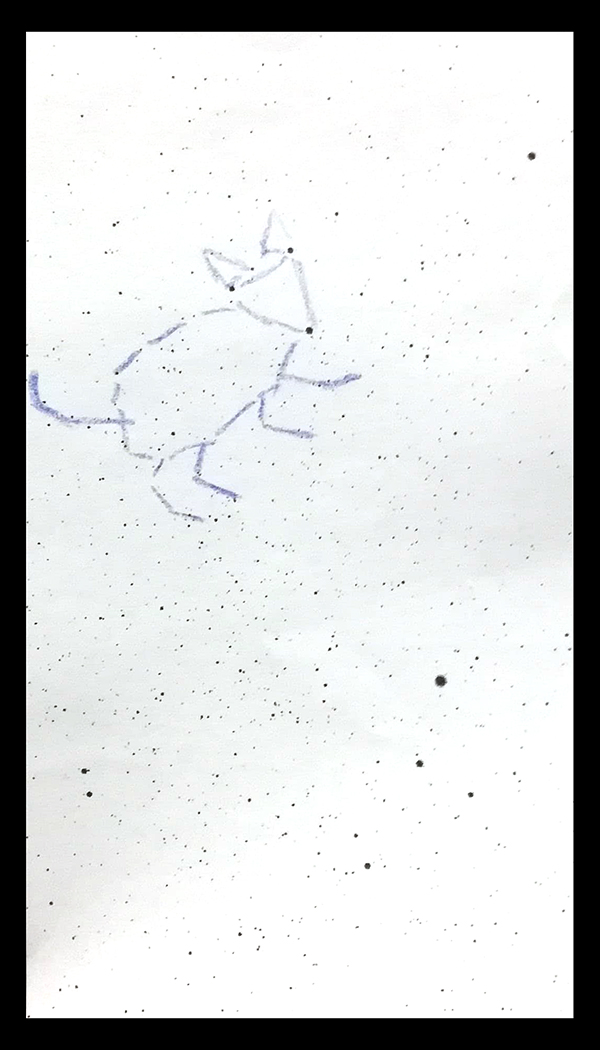
Visitors to the library program imagine their own constellations using star maps that model the night sky from surface exoplanets, planets around other stars, such as this one from 51 Pegasi b.[/caption]
The Schiele Museum of Natural History in Gastonia, North Carolina, wanted to increase students’ aptitude in astronomy concepts taught in the traditional school classroom over the summer by building their partnership with local libraries. Summer enrichment programs at regional North Carolina public libraries engage children ages 6–12 where they are. The programs are free and engage more children from lower socioeconomic backgrounds than typical visitors to the museum. Capitalizing on the library summer reading series called Universe of Stories, designed to inspire children to dream big in creating their own stories, the Schiele Museum developed “Stories in Stars.” The museum focused its programming on constellations, an area of astronomy rich with storytelling opportunities, and brought its portable planetarium and astronomy-based hands-on activities to audiences typically underserved with STEM enrichment.
Collaboration between Schiele and NASA’s UoL staff mainly revolved around enriching the program with a layer of astrophysics content beyond constellations. Schiele hoped to use astrophysics content that would allow students to be creative in developing their own stories. Through a collaborative back and forth, exoplanets— planets that orbit stars outside of the solar system—arose as the ideal subject for storytelling. Schiele developed a storyline where an alien on the surface of an exoplanet might imagine its own constellations. NASA’s UoL staff worked with subject matter experts including Dr. Robert Hurt, a visualization scientist at IPAC, to create star maps that accurately depicted the night sky from known exoplanets. Schiele was then able to take these star maps and have participating children create their own constellations and develop original night sky stories. The program is now part of Schiele’s mobile planetarium program, which takes the planetarium to schools upon request.
Evaluation
The Informal Learning Network and its web of collaborators was originally framed by NASA’s UoL as a professional development effort for educators from the informal learning community. Over time, it has become a professional learning community where all participants are both experts and learners. NASA’s UoL came to the table with authentic science stories and questions, images, data, and a network of scientists and engineers interested in supporting STEM and STEAM programs. The informal educators came to the table with expertise in designing exciting multidisciplinary learning environments that engage diverse audiences.
After an initial round of webinars, NASA’s UoL worked with Cornerstone Evaluation, an outside evaluator, to assess the effectiveness of the webinar series in building capacity among the informal institutions and their staff. Cornerstone surveyed webinar participants using Likert scales and open-ended response questions to determine the value and usefulness of the resources, as well as the effectiveness of the professional development content. The formative evaluation was then used to inform future sets of webinars. The evaluation identified some specific resources that participants found to be particularly appealing in reaching and engaging their audiences. In a series of survey items that asked participants to rate the usefulness of a variety of UoL resources, images resources, data visualizations and activities specifically designed for informal learning environments were consistently rated highest (4.3 on a 5-point scale).
The Maryland Science Center developed an interactive planetarium show where visitors learn about the various tools used to observe the universe. During the show, visitors are encouraged to explore the imagery for themselves using color filters, diffraction gratings, and more.[/caption]
The evaluation of the Community of Practice’s documented gains in participating professionals’ perceptions of their own knowledge of UoL science content (pre- mean rating = 2.9, post- mean rating = 4.1) and their familiarity and confidence in using UoL resources (pre- mean rating = 2.7, post- mean rating = 3.9) as a result of their experience with NASA’s UoL Informal Learning Network. Anecdotal self-reporting by the partner institutions shows that their awareness of astrophysics science themes (e.g., exoplanets, life cycle of stars) and their interactions with astronomers increased through their partnership in this program.
"The best moments of this project were seeing the educators and subject matter experts working together. It really was the spark for the final activity development push and inspired us to think deeply how to showcase this great space science content through creative experiences at the museum. I think a genuine strength of UoL is serving as the bridge between these two communities to provide more authentic potentials for collaboration.”
—Darrell Porcello, Children’s Creativity Museum
The evaluation by Cornerstone identified one element of the initial set of webinars that could use adjustment. NASA’s UoL had placed heavy emphasis on providing astronomy content knowledge to the sites in the first round of webinars. This was intended to help non-astronomy professionals become knowledgeable enough about the content to be able to adapt the resources for their audiences, but in a survey question that asked participants to rate the value of the three main elements of each webinar (i.e., science content background, relevant teaching and learning resources, and interaction with experts), discussion of relevant resources was rated higher than both content background and scientist interaction. The webinar participants wanted more focus on how the teaching and learning resources have been used in the past and discussion about how they could be adapted in the future to most effectively share specific astrophysics topics. As a result, NASA’s UoL rebalanced the webinars by changing the order of presentation, removing some astronomy content, and redirecting the focus toward resources and their utilization.
Cornerstone also completed a summative evaluation surveying later cohorts of Community of Practice members that included those who had received stipends to implement programs as well as those who had not. In Likert scale measures of knowledge, interest/engagement, and skills, participants who were funded to implement programming using NASA’s UoL resources rated their own gains as being significantly higher than other participants in the Community of Practice.
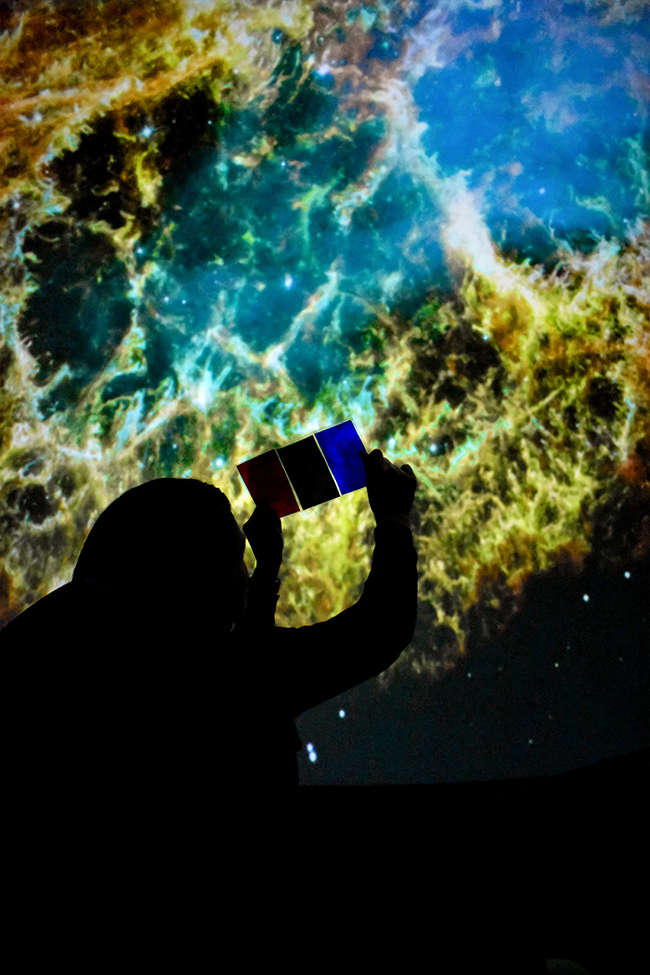
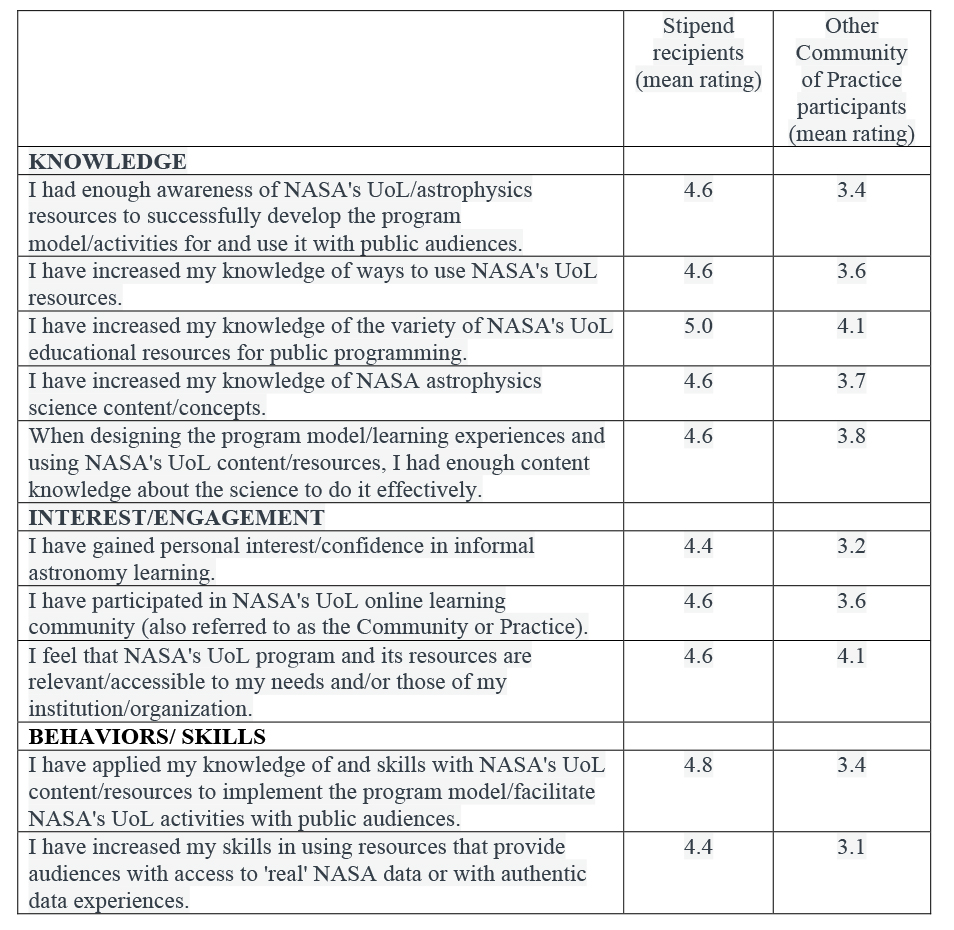
"I enjoy having the resources and exhibit materials available for the library to use. They have really helped to expand our science programming, and the community has been very responsive and supportive to all of the programs and exhibits.”
—Carrie Kurata, Cerritos Library
Through this partnership, NASA’s UoL, ASTC, and Smithsonian Affiliations aimed to bring resources to organizations that could take them and reimagine them in innovative ways to create ongoing and lasting experiences for their visitors. Nearly all respondents to the evaluation who used NASA’s UoL content or resources, either in documenting shareable ’program models or in developing learning experiences for their audiences, will continue to use them in the future.
"The opportunity to access resources for our community and for them to continue to benefit even after the program’s conclusion is beyond worthwhile.”
—Annette Eshelman, Springfield Museum of Art
Lessons learned for moving forward
NASA’s UoL Informal Learning Network is a multitiered collaboration, building an ecosystem of organizations and professionals invested in strengthening science learning and literacy. As stated in the OST STEM: Building Experience, Building Bridges conference report, “...strong partnerships can be difficult to form and maintain, particularly with respect to issues of expectations, contributions, and trust” (Bevan et al. 2010). Perhaps our most important lesson learned is that building a national Informal Learning Network is not just one partnership, but multiple partnerships, each requiring concerted coordination efforts, time, and attention.
A key component to the success of the Informal Learning Network is that it encouraged buy-in from partner organizations by providing an incentive for each organization to bring its best strengths to the table. NASA’s UoL, ASTC, and Smithsonian Affiliations held an open-ended call for applications to receive a small amount of seed funding for NASA’s UoL program model development. Informal learning institutions then applied with proposed astronomy-themed learning experiences that aligned with their institutional priorities and expertise. Some institutions such as art museums that were less comfortable with astrophysics content proposed STEAM learning experiences that combined their expertise in art and visual thinking methods with astrophysics content. Other organizations with experience in engaging learners with disabilities worked with their audiences to adapt NASA’s UoL resources to be more inclusive. Having such an array of organizations contributing to this partnership allows for a national reach with new, diverse audiences.
In our @NASA’s Universe of Learning workshop, participants are getting artistic! They’re learning how to engage students in science-education through art. #SmithsonianInSession pic.twitter.com/5M0dlvZb1H
— @SIAffiliates (@SIAffiliates) June 23, 2019
Building an informal learning network with people from so many areas of expertise—science, art, education, community engagement—has produced an incredible assortment of new, innovative programs that would not have been possible for NASA’s UoL to accomplish alone. These diverse organizations have each approached the integration of astrophysics content into their programming in their own manner, directly connecting the public with NASA science and reflecting unique institutional missions.
This partnership does not end here. The Community of Practice continues to grow and connect more museums, libraries, and other organizations with NASA’s UoL. Some of the informal learning sites are stepping into leadership roles to present their experiences at webinars, workshops, and conferences, mentoring a new set of organizations in the utilization of these resources. NASA’s UoL, ASTC, and Smithsonian Affiliations are working to propagate these documented program models to be used by new organizations in new ways with new audiences, further helping people discover the universe for themselves.
Acknowledgments
The authors wish to thank the entire NASA’s Universe of Learning team. The development of the Informal Learning Network was supported by the National Aeronautics and Space Administration under Award Number NNX16AC65A to the Space Telescope Science Institute, working in partnership with the Harvard–Smithsonian Center for Astrophysics, Caltech/IPAC, Jet Propulsion Laboratory, and Sonoma State University. Any opinions, findings, and conclusions or recommendations expressed in this material are those of the authors and do not necessarily reflect the views of NASA.
Erika Wright (erika.wright@cfa.harvard.edu) is is a science education specialist at the Center for Astrophysics | Harvard & Smithsonian in Cambridge, Massachusetts. Timothy Rhue II (trhue@stsci.edu) is senior informal education specialist at Space Telescope Science Institute in Baltimore, Maryland. Mary Dussault (mdussault@cfa.harvard.edu) is a science education program manager at the Center for Astrophysics | Harvard & Smithsonian in Cambridge, Massachusetts. Brandon Lawton (lawton@stsci.edu) is senior education and outreach scientist at Space Telescope Science Institute in Baltimore, Maryland.


